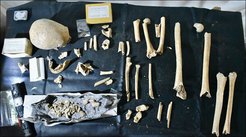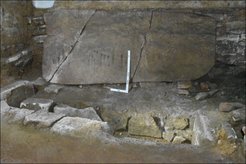Likely Identity of the Remains of Bishop Teodomiro Confirmed
Research reveals likely remains of discoverer of St James’ Tomb
Until recently, little was known about Bishop Teodomiro, after St James the Apostle one of the most important figure associated with the pilgrimage to Santiago de Compostela. Now, a interdisciplinary investigation has conducted a comprehensive analysis of the potential remains of the bishop using advanced techniques. It provides new insights into the identity of the individual and the historical context of this significant discovery.

Between 820 and 830 CE, a hermit named Pelayo witnessed a shower of stars descending upon a field. Investigating, he discovered an ancient mausoleum and quickly informed the Bishop Teodomiro of Iria-Flavia (Padrón, Spain). After three days of meditation and fasting, the bishop declared that the mausoleum contained the remains of the apostle James and two of his disciples. This revelation was communicated to King Alfonso II of Asturias, who then commissioned the construction of a small church around the tomb. This event marked the beginning of the legend of the apostle Santiago’s tomb, recorded in the 12th century, and the Jacobean phenomenon, which continues to draw millions of pilgrims and visitors to the cathedral in Santiago de Compostela, Galicia, Spain.
Despite the story’s significance, Bishop Teodomiro’s his existence was questioned until the latter half of the 20th century, when a tombstone marking his death in 847 CE was discovered in the Cathedral of Santiago de Compostela. Beneath this tombstone, remains were found and initially identified as belonging to an elderly male. However, a reexamination in the mid-1980s suggested the remains were of a woman, raising doubts about their connection to the bishop. Now, a international research team led by Patxi Pérez Ramallo of the Norwegian University of Science and Technology in collaboration the Max Planck Institute of Geoanthropology, the University of Stockholm and others has reexamined the remains, using osteological, stable isotope, radiocarbon, and ancient DNA analyses.
Mixed diet mix of marine and terrestrial sources

The latest osteological investigation confirmed that the tomb contained the bones of a single individual, an adult male likely over 45 years old. Isotope analysis revealed a diet dominated by a mix of marine and terrestrial protein sources, slightly different from what might be expected of Christian monks of the time, who followed specific dietary rules. However, diet can reflect various factors, including religious practices and local traditions. Radiocarbon dating placed the sample within 673 to 820 cal. CE, consistent with a death in 847 CE. when the evidence for marine protein sources is taken into account.
Stable oxygen isotope analyses suggested the individual lived near the coast, aligning with the location of Iria Flavia. The archaeogenetics study, conducted at Stockholm University, revealed that the individual’s genetic profile deviated slightly from modern Europeans, showing closer affinities to Roman Iberians, southern Iberian Visigoths, and Iberian Islamic populations — consistent with someone living in Spain 1,200 years ago. These results also align with previous studies showing migration patterns in response to the Umayyad Caliphate's conquest of the Iberian Peninsula in the 8th century.
While it is challenging to authenticate the identity of someone from 1,200 years ago, this study presents evidence consistent with Bishop Teodomiro's identity. The findings suggest that these remains could indeed belong to him, potentially making them the oldest identified historical figure in Spain and one of the oldest in Europe.













